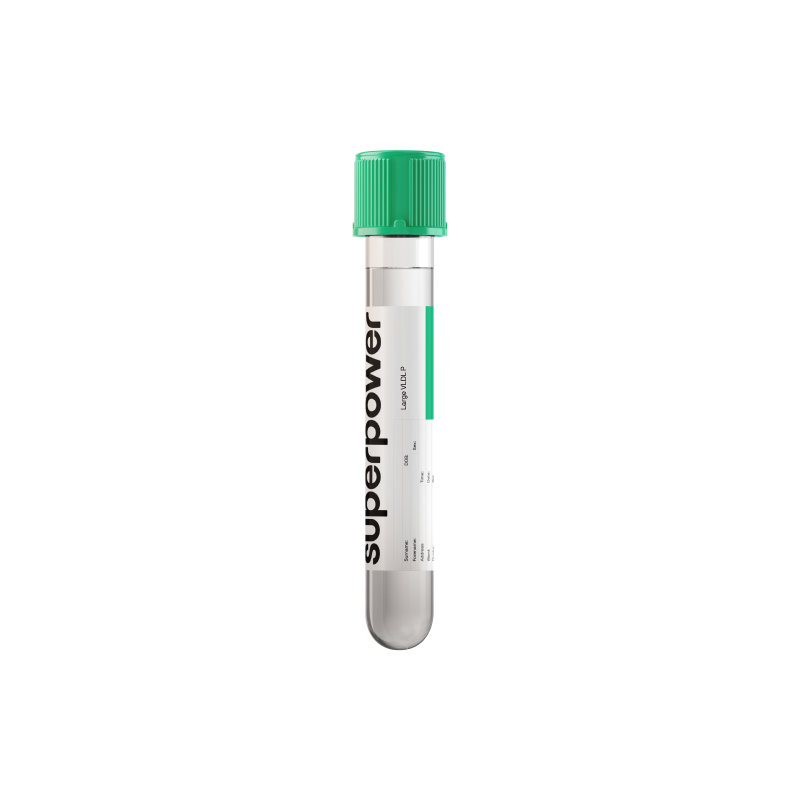Large VLDL-P testing quantifies the number of large, triglyceride-laden particles your liver releases into circulation. These particles are tightly linked to insulin resistance, fatty liver physiology, and cardiovascular risk.
By showing traffic volume—not just cholesterol cargo—it highlights hidden risk and offers a sensitive, trackable target for lifestyle and therapeutic change.
Key Benefits
- Measure large VLDL particle levels—the big, triglyceride-rich carriers in your blood.
- Spot atherogenic remnant cholesterol burden linked to heart risk beyond standard cholesterol.
- Flag insulin resistance pattern, supporting earlier diabetes prevention efforts.
- Guide treatment intensity by revealing triglyceride-rich particles not captured by LDL cholesterol alone.
- Protect liver health by linking high levels with fatty liver risk and progression.
- Flag pancreatitis risk when very high alongside triglycerides, especially above 500 mg/dL.
- Track response to diet, weight loss, omega-3s, or medications targeting triglycerides.
- Best interpreted with fasting triglycerides, non-HDL cholesterol or apoB, and glucose.
What is Large VLDL P?
Large VLDL P is the number of large very-low-density lipoprotein particles circulating in your blood. VLDL are lipid shuttles made by the liver to export fat produced in the body (endogenous triglycerides). Each VLDL particle carries one structural protein (apolipoprotein B-100, or apoB-100); the “large” subclass has a bigger core packed with triglyceride. The “P” refers to particle count, emphasizing how many of these large triglyceride-rich carriers are present rather than how much fat they carry.
Functionally, large VLDL deliver triglyceride to muscle and fat for energy use and storage, then shrink as an enzyme trims off fat (lipoprotein lipase, LPL). Along this route they become smaller VLDL, remnant particles (VLDL remnants/intermediate-density lipoprotein, IDL), and eventually low-density lipoprotein (LDL). Large VLDL P therefore reflects the liver’s outbound traffic of triglyceride-rich lipoproteins and the upstream pool that feeds remnant and LDL formation. It offers a snapshot of how actively the body is moving endogenous fat through the bloodstream and the potential for cholesterol-rich remnants to appear as these particles are progressively broken down (lipolysis).
Why is Large VLDL P important?
Large VLDL P counts the number of large, triglyceride‑rich very‑low‑density lipoprotein particles your liver releases into the bloodstream. These particles shuttle energy (triglycerides) to muscle and fat, and their abundance signals how well your body handles fat and insulin. Because large VLDL give rise to cholesterol‑rich remnants that can enter artery walls, this marker links the liver, pancreas, and vascular system. Most labs consider lower values preferable within their reference interval.
When this number is on the lower side, it usually reflects efficient hepatic fat packaging, prompt lipolysis by lipoprotein lipase, and good insulin sensitivity. People are typically asymptomatic, and arterial and liver fat burdens tend to be lower. In lean children and premenopausal women, values often sit naturally low. Very low values can also occur with low dietary fat intake or reduced liver VLDL production; symptoms, if present, come from the underlying state rather than the lipoprotein itself.
Higher values point to hepatic VLDL overproduction, commonly driven by insulin resistance and liver fat. As large VLDL are lipolyzed, they generate remnant lipoproteins that are atherogenic and promote small, dense LDL and lower HDL. Most people feel nothing, but clues can include central adiposity or acanthosis nigricans. Marked elevations track with hypertriglyceridemia and pancreatitis risk, and are seen in familial triglyceride disorders, obesity in teens, PCOS in women, and physiologically rise in pregnancy.
Big picture: Large VLDL P integrates liver fat metabolism, insulin signaling, and arterial risk. Interpreted alongside triglycerides, ApoB, remnant cholesterol, and liver enzymes, it refines cardiometabolic risk and long‑term outcomes like atherosclerotic disease and fatty liver progression.
What Insights Will I Get?
Large VLDL-P measures the number of large very–low-density lipoprotein particles circulating in blood. These liver-made, triglyceride-rich carriers move energy to muscles and fat. At a systems level, they shape post-meal fat handling, liver fat balance, and the pool of cholesterol-rich remnants that interact with artery walls, linking this marker to metabolic health, cardiovascular risk, and fatty liver biology.
Low values usually reflect lower liver output of triglyceride-rich particles and/or efficient clearance by lipoprotein lipase. This pattern aligns with lower plasma triglycerides, better insulin sensitivity, and fewer atherogenic remnants. Lower levels are common in children and lean premenopausal women. Very low results can occur with undernutrition or rare variants that enhance lipoprotein clearance.
Being in range suggests balanced triglyceride transport—adequate energy delivery without oversupplying the circulation. It points to stable insulin–glucose dynamics and a smaller remnant cholesterol burden. For cardiometabolic risk, consensus trends place optimal toward the lower end of many laboratory intervals.
High values usually reflect hepatic overproduction of VLDL or slower peripheral clearance. This accompanies insulin resistance, metabolic syndrome, type 2 diabetes, hepatic steatosis, and hypertriglyceridemia. It increases cholesterol-rich remnants, fosters small dense LDL formation, stresses endothelium, and at very high triglycerides raises pancreatitis risk. Levels are typically higher in men, rise with age, and increase across pregnancy. Low thyroid hormone, nephrotic-range protein loss, and inherited hypertriglyceridemias can contribute.
Notes: Large VLDL-P is commonly measured by NMR; cutoffs vary by lab. Fasting status, recent alcohol, acute illness, and day-to-day variability influence results. Several medications (estrogens, glucocorticoids, certain beta-blockers, thiazides, antiretrovirals) can raise triglyceride-rich lipoproteins.



.svg)



.png)
.png)
.png)
.png)








